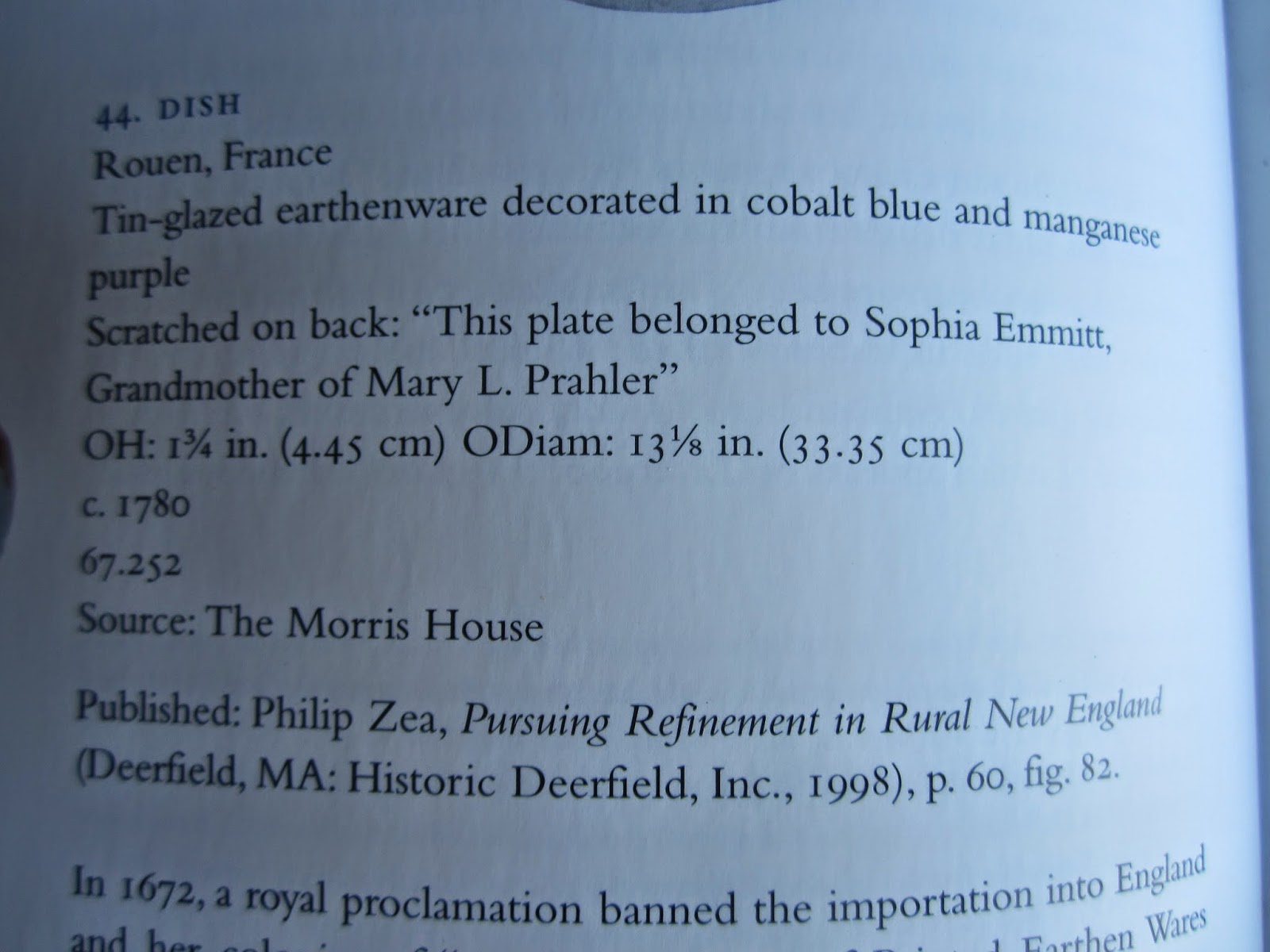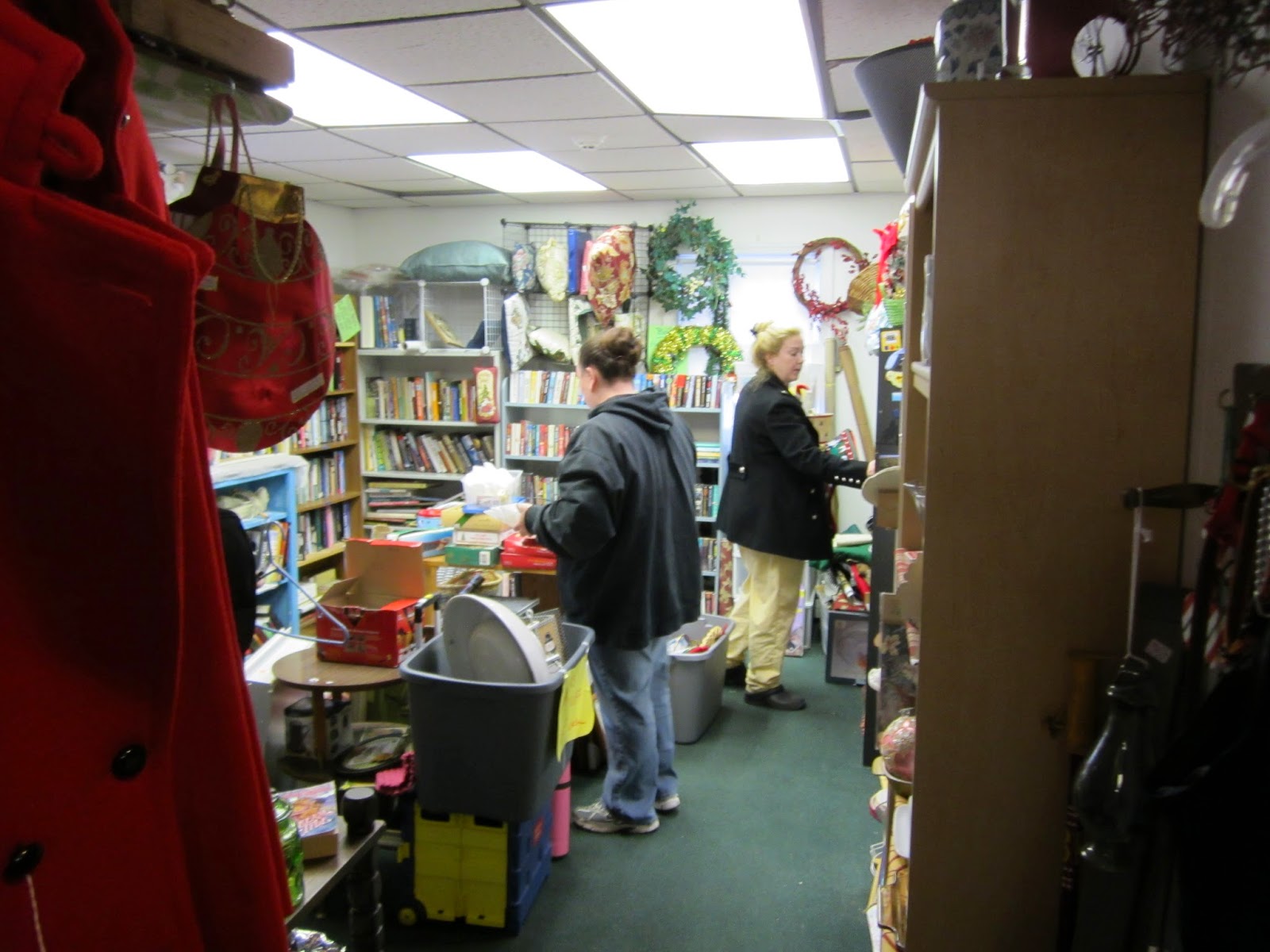Cowboy Down
A Conversation Between Two Professional Thrift Shopprs
Part Twelve (B)
"Risk"
“While
I was saying that; ‘SHE’S BUYING IT’, a whole mountainside of mentally stored
FACTS collapsed from its... internal mountainside memory storage...
distribution... poise...
avalanching THROUGH my frontal eye-to-mind amphitheatre (forehead region) to... just above the
eyes and... ‘was about to’...:
“That’s
another four-five-six seconds?
Whose counting? What
happened? IN those seconds; WITHIN
those seconds?”
“I: ‘That is a mid-eighteenth century
French (Rouen) Delft (‘Faience’) charger (large serving platter). I know that because it is in that
Deerfield book. Yeah that one is
identical and is ALSO in the Deerfield Delft book too; that same charger, but
THERE it is collaborated of it’s New England usage service (heritage) by a
Middletown, CT – Wesleyan University archeological outhouse (‘privy’) (old
fashion toilet) ‘dig’ fragment identification... by a broken but nearly ‘all
there’ identical charger PICTURED (too) (in color) in that (Deerfield) Delft
book I...”
“Know
this; what she is clutching: THAT
IS ONE: IT IS IT.”
“Right. Soooo... She turns to further face down
the isle away from me but then (two seconds total?) radically turns back to her
right, bends over and down, shoves the charger back on to the bottom china isle
shelf while raising her head and... is... yelling ‘ZEE-nah WAIT’ down the isle
as she takes off (scampers) away down the isle LEAVING THE CHARGER on the
bottom self. I am there (upon it,
grabbing it) in two more seconds (probably less) in the ‘it’s MINE’ in hand and
I am, now three more seconds, examining the BACK of the charger to positively
affirm (this taking but one second more) that ‘it is real’ and that this
‘really happened’ or is ‘still really happening’. Is it?”
“How
many seconds in total?”
“UNDER twelve seconds this WHOLE...
identified antiques acquisition... took leaving me ‘standing there’... HOLDING
THE CHARGER up side down and the She... gone. ‘OVER’... it is as I notice the two ‘old staple repairs’ on
the ‘oven blackened back. That
back blacking is, correctly understand, colonial NEW ENGLAND fireplace kitchen
beehive bake OVEN blackened meaning;
PIES were baked in this ...once ‘serving’ charger... that then had
fallen away, as a design form (French Delft serving vessels), to become ‘out of
fashion (no longer used)’ so had become ‘repurposed’ (in the sense of today’s
trendy and foppy decorator’s lingo) in the colonial home as a ‘PIE PLATE’ for
‘baking pies’. Here I serve notice
that... that usage... and the newly introduced (ca. 1780s) DESIGN FORM of
baking dishes especially designed IN THE UNITED STATES OF AMERICA for ‘baking
apple pies’ (that design form) titled ‘pie plates’: Oh no and oh yes; ‘American as apple pie’: There were no ‘pie plates’ by title
until the United States introduced the design form ‘late’ (after redware
pottery had been an American ceramic industry for over one hundred years); past
the mid eighteenth century ALTHOUGH ‘baking fruit pies’ was rising in
popularity ‘prior to’ (the introduction of the ‘pie plate’ ‘baking dish’)
making the usage adoption (repurposing) of THIS CHARGER ‘a natural’
‘repurposing’. YIKES:”
“And
that’s all true and.... ‘How many seconds’ did this take? And what does this have to do with
‘risk’... in thrift stores?”
Well: Are you ‘ZEE-nah’? Are you She (in the silver foil rocker
boots throwing ‘it’ back)? Or are
you me?” Risk is a variable. One controls. Ah...: Let use
documentation and work with that while drifting towards... ah... ‘risk’.
The
worse part of the army of design back ground I brought to the ceramic isle
discernment is the first reference book I mentally mention... to myself (not
you). In total, this is the third
blog ‘story’ that I have specifically referred to... not only this book... but
the SAME specific pages in that book.
Ironically... it is ... in my favor? That book gained an expressive three paragraph notice in the
SECOND reference usage. That came
after the first relevant object denotation... found in another earlier story...
that happened to have the odd luck of ‘being on the same page’ ‘too’. Stepping past ‘isn’t that (being on the
same page) CUTE’ I re-state the... emphatic... useful... relevance... of THAT BOOK and those pages by (1)
observing my absurd ‘luck’ of this French ‘Rouen’ charger ALSO being in the
book and on the same... God damn pages... BUT TOO I here below reproduce the
(three paragraphs) of TEXT... from the second story. Some of the re-quote is relevant only to THAT story but I
include it for it does hint at ‘using design to critique’. This is cut and pasted from the long...
tale (available in this blog’s archives) titled “SUMMER PLACE” (Part
Thirty-Five B):
Philip
Zea, “PURSUING REFINEMENT IN RURAL NEW ENGLAND 1740-1850’, Historic Deerfield,
Deerfield, MA, 1998. This may be
considered a flawless peek at ‘good taste in New England decorative arts’. Hardcover or paperback; buy the
hardcover. The paperback wears...
out. The hardcover costs a lot
more... if a copy can be found.
On
page 60 at Figure 84 our visiting eye... has already ‘I spy’... what they
‘Figure 84 – Platter”. In
color. Nice. There is no positive arts (design
qualities) mentioned in the Deerfield history focused descriptive text. In the text they also positively
mention the New England preference for the ‘dark’ blue. The reverse of that positive is the
...legacy... negative of the English mocking Americans for this preference for ‘dark’ blue... that
stands to this day... and DOES qualify one’s art eye when ‘looking’ at
transferware... but that is too much for today’s lesson. Rest assured: Point upon point upon New England good taste point is
found... in this book.
As
a spot-focus on ‘I am trying to tell a bigger tale’ from within these stories,
vignettes and pontificates, this actual page in the book; page sixty... with
the platter at the bottom... JUMPS at the top of the next page; sixty-one... to
‘Figure 87 – Tobacco Tongs’, with description ...that again focuses on
Deerfield history. These are ‘Pipe
Tongs’ by consensual lay antiquarian title, ...and... ‘A SET’ of pipe tongs
were the subject of a whole tale by I; “A DOOR KNOCK”, a nine part tale (also
available in blog archives). The
tongs at Deerfield are ‘signed’ ‘American’. The tongs in the tale were ‘unsigned’. But: The ‘lines’ (‘design’)
of the story’s tongs ...were ‘better’. The Zea set is ‘a little clunky’.
Now,
in this tale of the thrift shop professionals talking, I return again to this
same book and same pages for... ABOVE the (transferware) platter on page 60...
is shown a French ‘Rouen’ charger... ‘identical’ to this thrift store china
shelf throw back... BUT: I know
more for I... being design infatuated I (eye), humbly added a second Deerfield
‘reference book’ to my... I (eye):
Amanda E. Lange DELFTWARE AT HISTORIC DEERFIELD 1600-1800, Deerfield,
2001, here using page 84, figure 26 and number 44. This reference shows the fragment charger from Middletown,
CT and, again, the charger in the Deerfield collection, with text.
Ok...
so that is what rolls down the mental mountain first. A few seconds later I am ‘holding hands’ upon the charger
and look at its back to affirm MORE.
The more is the usage history of the once charger being converted to a
...baking dish... to ...bake pies... in a colonial New England fireplace
kitchen. I... design I (eye) again
using the ‘know this’ that ‘pie plates’ were (are) an American design
innovation and that THIS French ‘Faience’ charger ‘was used for that’. For this ramshackle yet GLORY ‘American
as apple pie’ design iota... I go back to about 1973-74 when I was studying
American ceramic design ‘traditions’ (histories) ‘in college’ and ‘always remember
reading’ Edwin Atlee Barber’s TULIP WARE OF THE PENNSYLVNIA-GERMAN POTTERS AN
(sic) HISTORICAL SKETCH OF THE ART OF SLIP-DECORATION IN THE UNITED STATES, NY,
Dover, 1970... who on pages 101-102 explains ‘this’ (America as apple pie
PLATES) ...WITH... a further reference to “Mercer” ...the ‘Mercer tool
book’. Just to really rap the
reader on the head about the use of reference books... by I (eye)... ‘Mercer’
appears WITH a discussion of Eric Sloan books in a rather long tale on this
blog: (Coy – Part Nine – “Crazy Man” – [C]). The point, for this tale, is that I am ‘in isle’ at a thrift
store using ‘stuff’ I read FORTY years ago AND was studied in Barber’s
reference to Mercer... then... TOO.
So... like... loose the silver foil booties? If your gonna loose the risk...
Doing
this?
I
am not done. What about those
‘staple repairs’? “WOW!” and
...what does that mean. WELL...
romantic conjecture gives us, option one, that ‘a collector’ once owned this
rejected pie plate and ‘had it’s (old usage) crack ‘fixed’ (stabilized)... for
their ‘collection’ of ‘Delftware’ found in Colonial New England. OR... option two... one ‘knows’ that
‘they did (were doing) staple repairs’ a LONG, long time ago so that it COULD
mean that Mrs. Colonial Fireplace Kitchen Grandmother herself... who used this
‘pie plate’ to ‘bake apple pies’ for her... WHOLE LIFE... after getting ‘it’
(the pie plate baking dish) from HER mother... ‘had it stapled’ (to stabilize
the usage crack) and KEPT ON USING IT UNTIL ...she died... and it.... started
ITS journey (Part Seven) to the thrift store.
“It’s
still on its journey!”
“Yeah but I, ah, moved its decimal place (increased it’s dollar value as an art object).
“Yeah but I, ah, moved its decimal place (increased it’s dollar value as an art object).
“It’s
really a wonderful thing. And it
has a wonderful story.”
“Yeah but they (the reader) doesn’t care about that. All they care about is the money. The risk.”
“Yeah but they (the reader) doesn’t care about that. All they care about is the money. The risk.”
“How
can you not love this thing?”
“Because
your greedy and insensitive.
That’s why your in the thrift shore? Because your greedy and insensitive? How does THAT affect risk?”
“Weeding
your garden; that’s what YOUR risk at thrift stores is”.
“Yours
too. Well... it’s actually sort of
the opposite.”





















































